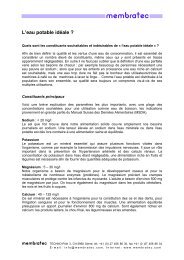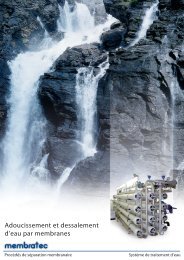Membrane water softening and desalination - Membratec
Membrane water softening and desalination - Membratec
Membrane water softening and desalination - Membratec
You also want an ePaper? Increase the reach of your titles
YUMPU automatically turns print PDFs into web optimized ePapers that Google loves.
<strong>Membrane</strong> <strong>water</strong> <strong>softening</strong><strong>and</strong> <strong>desalination</strong><strong>Membrane</strong> separation processesWater treatment systems
<strong>Membrane</strong> <strong>water</strong> <strong>softening</strong> <strong>and</strong> <strong>desalination</strong>FeedConcentrateProductPermeatecarrierGlueReverse osmosis skid Spiral wound module configuration Detail of pressure vessel<strong>Membrane</strong> technology<strong>Membrane</strong> technology allows the rejection ofanything down to simple ions such as Na + <strong>and</strong> Cl - .A number of treatment applications are thereforepossible in the municipal <strong>and</strong> industrial <strong>water</strong>fields.Water <strong>softening</strong>Water <strong>softening</strong> (e.g. hardness <strong>and</strong> sulphateremoval) using membrane filtration processesrepresents an interesting treatment application forimproving the quality of fresh <strong>water</strong>. Watercontaining high amounts of sulphates or calciumcan be satisfactorily treated thanks to the very fineporous structure of the membrane, which,depending on the chosen pore size (smaller poresrequire a higher applied pressure), allows a 94%to 99% rejection.Disinfection by-product precursors removalDisinfection by-products (DBPs) are a major targetcontaminant <strong>and</strong> they are formed when naturalorganic matter (NOM) in drinking <strong>water</strong> reacts withchlorine or other chemical oxidising agents.Reverse osmosis <strong>and</strong> nanofiltration membranescan reject more than 90% of the DBP precursorsfrom surface <strong>and</strong> ground<strong>water</strong>s with a high organicload.DesalinationSea<strong>water</strong> <strong>and</strong> brackish <strong>water</strong> treatment are themost common applications of reverse osmosis inthe municipal <strong>water</strong> field. With the introduction ofspecially designed energy recovery systems,modern plants are becoming more cost efficientthan traditional <strong>desalination</strong> methods such assea<strong>water</strong> distillation.Reverse osmosis <strong>and</strong> nanofiltrationThe most selective filtration technique is definedas reverse osmosis (RO), whereas nanofiltration(NF) pores are typically larger than the reverseosmosis ones, thus allowing to differentiatebetween desired <strong>and</strong> undesired raw <strong>water</strong>constituents.As particle-free <strong>water</strong> (< 1 NTU) is required forboth RO <strong>and</strong> NF, pretreatment steps such as s<strong>and</strong>filtration or ultrafiltration (UF) are often necessary.<strong>Membrane</strong> material <strong>and</strong> configurationReverse osmosis <strong>and</strong> nanofiltration membranesare often made from cellulose acetate orcomposite polyamides. In the most commonconfiguration, 1m-long spiral-wound elements areinstalled in pressure vessels (up to eight elementsper vessel).Compactness <strong>and</strong> modularityAn advantage of all membrane processes is thecompactness of the treatment plants, which canbe easily extended thanks to their modular design.Applied pressure <strong>and</strong> power consumptionExternal pressure is applied to the saline solution,so that <strong>water</strong> can flow by diffusion from a moreconcentrated saline solution through thesemipermeable membrane to the permeate side.The operating pressures depend on the quality ofthe raw <strong>water</strong> <strong>and</strong> on the type of membrane:• Softening of fresh <strong>water</strong>: 8 – 15 bar• Brackish <strong>water</strong> <strong>desalination</strong>: 15 – 25 bar• Sea<strong>water</strong> <strong>desalination</strong>: 40 - 80 bar (modernplants equipped with energy recovery systemshave a power consumption of 2 – 3 kWh/m 3 ).For all problems related to <strong>water</strong> treatment,<strong>Membratec</strong> can offer an integrated membrane solution adapted to your needs.membratec TECHNO-Pôle 3, CH-3960 Sierre, Tel. ++41 (0)27 456 86 30, Fax ++41 (0)27 456 86 34E-mail: info@membratec.com, Internet: www.membratec.com






